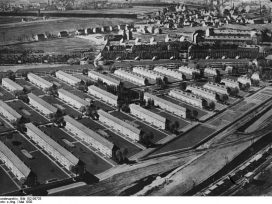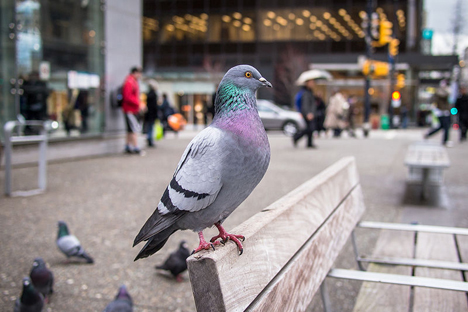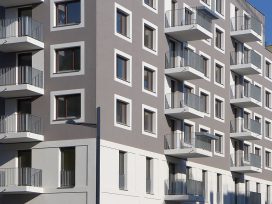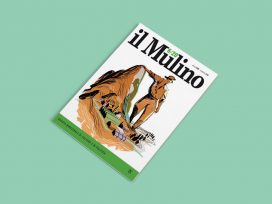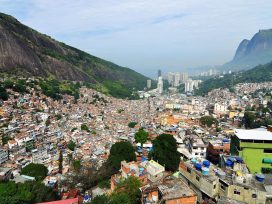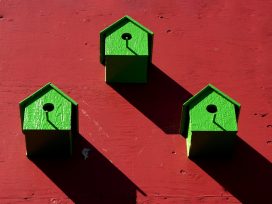On 22 June 1966, the New York Times published an article which in its way made history. Thomas P. Hoving, Parks Commissioner, condemned in the severest terms the littering and vandalism in Bryant Park. The article singled out for special comment homosexuals who “pulled faces” at other park-users. It also mentioned the large number of “winos” who gathered in these green spaces. The park he described was in crisis – overrun with homeless people who felt no shame about fouling the place with their refuse.
This was followed by a strap-line: “And Then There Are the Pigeons”. This creature which had, until then, enjoyed an excellent reputation, was suddenly now regarded as New York’s “most persistent vandal […] the pigeon eats our ivy, our grass, our flowers and is a health threat […] But everyone seems to want to feed them […] It’s impossible to stop the pigeon-feeders.” After calling for a “clean-up”, more in exasperation than in realistic hope that anything would be done, he used, for the first time, an expression which would from now on attach itself to pigeons everywhere: “Commissioner Hoving calls pigeons ‘rats with wings’.” Woody Allen’s Star Dust Memories (1980) picked up what was still then a New York expression, thereby putting it into global circulation.
In a very short space of time the image of pigeons had been transformed. From epitomizing the beautiful, the health-giving and the good, by the mid-twentieth century they had become urban pests, ugly disease-carriers. How did this happen?
The angel of Fordism
That this bird was held in such high favour for so long had a lot to do with its role as a copious producer of one of the world’s best naturally occurring manures. Pigeon-droppings were highly valued in agrarian societies for many centuries all around the world. Dovecotes, found in even the remotest regions, are testimony to this. Their symbolic value for Christians, as emblems of the Holy Spirit, only reaffirmed the general view of them as peaceful, monogamous and wholesome. In Catholic teaching they were the only creature on earth so pure that no demon could ever enter them.
The earliest written records suggest that pigeons have been the constant companions of humankind and were among the first animals to be domesticated. This probably took place in in the Middle East and/or North Africa and in the earliest of permanent human settlements. Graphic, sculptural and literary accounts of the relationship between people and pigeons go back 5000 years. Homer, Socrates and Aristotle were all familiar with them and wrote about their breeding and domestication.
All domesticated and town pigeons are descended from wild rock doves, which still exist. Their urban descendants are to be found, outside the polar regions, wherever there are human beings, though their distribution across Africa and Asia is limited. The dove is a so-called Kulturfolger or “companion species” in Donna Haraway’s phrase. Their adaptability, to human beings and their built environment, has served them well.
The adobe or stone construction of the earliest human dwellings seems to have been so similar to their nesting sites in the wild that they needed little encouragement to move in and stay. Doves do not build nests but make themselves at home in ready-made nooks wherever they find them. Since they seem quite unaware of any distinction between natural and man-made environments, they felt quite at ease among humans and soon lost their shyness with them. These character-traits made them ideal subjects for human intervention: and the rate at which they bred made them suitable for selective breeding. Darwin devoted several years of close study to this. Little wonder that they attained mythical status in many cultures.
Although the telegraph rendered them obsolete as news-carriers during the nineteenth century, doves remained an important source of fresh meat in Europe right up to the start of the twentieth. Their dung too was still in demand, as a weed killer when applied fresh, then breaking down into a powerful fertilizer. The Haber-Bosch process transformed agricultural methods and undermined that solid material basis which underlay the pigeon’s good reputation. Nitrates were the key to massively increased agricultural yields, so that a method to produce it artificially had far-reaching economic and social implications.
Chief among which was a sudden drop in demand for manure from pigeons. The promotion of chicken meat as an important food source, beginning the USA in the first half of the twentieth century, further reduced the value of pigeons. Even when farmed on an industrial scale, under massive physical and mental stress, chickens lay eggs and, in conditions where most other creatures would simply give up, carry on hoping to live. All of which alters our image of that paradisiac state which was the post-war economic miracle: no more “roast pigeon flying straight into people’s mouths” (a figure of German speech deriving from stories of Schlaraffenland, a mythical work-free world of ease and luxury – trans). As late as 1900, three-quarters of a million pigeons were eaten by the Viennese every year. But by the middle years of the same century they had vanished from the city’s diet. Mass-production and mass-consumption along Fordist lines drastically reduced the value of pigeons to their human hosts. After the Green Revolution, the dove ceased to be of any economic value in advanced industrialized societies.
The battle of the window ledges
The same economic changes, however, which left the dove’s “aura” looking distinctly shabby also led to an explosion of pigeon populations in the world’s cities. The Fordist post-war boom massively increased the amount of edible litter available to them. The development of shopping areas and pedestrian zones, delivered at the same time, among other things, a habitat which seemed to suit them very well. As in the first human settlements, pigeons made themselves at home and adapted once again to a new urban environment.
Their status altered accordingly. For example pigeon meat had been thought to promote the quick healing of wounds. Regarded as a health food, it was used to flavour soups and often served in hospitals. Yet the creature which had supplied this meat was now increasingly viewed as a spreader of contagion.
As standards of cleanliness improved in the home, so more and more care was now taken to keep the city’s outdoor spaces clean. Improved hygiene made people more anxious about the cleanliness of window-sills and back yards. Business owners and local politicians concerned themselves increasingly with the way shopping areas looked. And though squirrels carry more diseases than pigeons, it is allegedly the latter that “spread germs”. Our willingness to believe this suggests an urban order that is as much symbolic as it is material. Determined by a modernist vision of disciplined urban space, the commercial demand for clean shopping areas converges with an austere aesthetic of bio-social hygiene.
It isn’t only pigeons which are viewed as a blight on the city’s image – as parasitical, useless, at odds with its business ethic. Beggars, junkies, aerosol addicts and the homeless are among their human counterparts. Even the wholesale re-organization of the commercial areas and traffic-flows of Vienna’s third district was initially justified by the mayor on the grounds that the current arrangement resembled nothing so much as a Ratzenstadel (a “barn full of rats”). Warning signs in parks show evil-looking rats, which effects a remarkable semiotic short-cut: feed pigeons and you’re feeding rats. Even though, in German constitutional law, pigeons aren’t regarded as “pests” at all, the opposite view is asserted by building cleaners and others with a vested interest in ridding the city of pigeons. In the course of our permanent state of war with these birds, facades are draped with nets, like military installations. Window-ledges and pediments are lined with spikes. Pest-controllers are called in, instructions issued.
The visual politics of dirt
The sociologist Colin Jerolmack searched the New York Times archive from 1851 to 2006 for any comments in which pigeons were characterized as pests. He came to the following conclusion:
I contend that pigeons have come to represent the antithesis of the ideal metropolis, which is orderly and sanitized, with nature subdued and compartmentalized. While typified as a health issue, the pigeon’s primary “offense” is that it “pollutes” habitats dedicated for human use.
“Dirt”, as the anthropologist Mary Douglas showed, is first and foremost a social category (1966; 1982). It is the attribute “dirty” that taints a subject, necessitating its removal from a given space. The way this works is quite contrary to the common sense view: it isn’t because pigeons are actually dirty that they have to be removed from the urban space. Rather, they appear “dirty” because their presence conflicts with the way modern urban space is conceived. Hence it is above all their visibility which becomes a problem. Unlike other inhabitants of the “nature-culture borderlands” – badgers, polecats, deer – the pigeon is not found at the city’s edge but frequents its most visible most public spaces. Unlike rats and cockroaches, they emerge not only at dusk but during the daylight hours. They make no attempt to hide but are found in the thick of city life. They can fly away, too, and have always been able to, unlike the cat which can be kept indoors or the dog which can be kept on a lead.
Pigeons occupy an ambiguous status between domesticated and wild animals, since urban pigeons are the feral descendants of formerly domesticated birds. There is an “urban ecological perspective” from which they might be seen as a bastardized population that has refused to revert obediently to type. Domesticated pigeons released during the French Revolution simply joined their feral cousins: city life brings freedom – Stadtluft macht frei – and not only for people, it would seem.
Poisoning pigeons
In the popular press in Austria just after the Second World War, the pigeon briefly occupied an apparently incoherent status: as both victim and troublemaker.
Staff from the Viennese Animal Protection League have recently carried out an investigation, and what they have discovered is nothing less than an outrage: Vienna’s pigeons have been packed off to Bologna in large transports […] Only yesterday one of these transports [“Taubentransporte”] left for Italy from the Südbahnhof. 500 pigeons in six small crates embarked on the four-day journey to Bologna. The crates were almost entirely without food and water. (Quoted in Kathan 2001)
In all this excitement about the fate of the abducted pigeons, decent honourable Austria saw an opportunity to make a comeback. But even so soon after the war, the truth about the creature’s present status was plain to see. A Viennese solution was already being tabled:
Around 1500 pigeons are to be destroyed each year. The municipality has contracted a pest control company from Wien-Landstrasse, to carry out this controversial but sadly necessary task. The men of this company are executing a very clear plan to eliminate pigeons wherever they become a nuisance. Grains of corn coated with prussic acid are scattered. The creature drops dead the moment it swallows one of them. The Animal Protection League cannot intervene against this method of destroying pigeons, because it is completely painless and humane. (ibid.)
This claim that the use of prussic acid not only can but should be viewed as “humane” points to an unconsciously coded justification for the use of Cyclon B in the concentration camps. As such, it represents a step towards the relativization of Nazi crimes. The final twist came with the reporting of how other capitals were treating these birds which had become such a burden:
Moscow declares war on its pigeons: A series of investigations conducted by the Medical Faculty of Moscow University have shown that the city’s ever multiplying hordes of pigeons were responsible for the flu epidemic. Millions of the gurgling creatures are to be removed from the Soviet metropolis. With gigantic vacuum cleaners the pigeons will be sucked up from the streets and from around Red Square and re-settled in Siberia. (ibid.)
Nothing like an allusion to Siberian POW camps when you want to put the fear into post-war Austrians. With its monstrous claims (humanitarianism through prussic acid) and the no less monstrous proposed means of effecting this (vacuum-cleaners to literally suck these creatures out of the city), the style of reporting served to reinforce the “logic” by which the campaign was justified. The violence and deceit which it concealed so poorly must have struck (Austrian-American Viennese-dialect cabarettist and composer) Georg Kreischer too, upon his return to Austria from the USA in 1955. No wonder that perhaps his best known song, “Taubenvergiften im Park” (“Poisoning pigeons in the Park”) was banned on radio and television.
Unruly creatures: Authority and obstinacy
The philosopher Jacques Derrida devoted his last lecture to the sovereign as a wolf or beast, setting against this a “peace-loving and dove-like” counter-principle (Derrida 2009: 23). Dove and pigeon, thesis and antithesis, the olive-branch-bearer of the Book of Genesis and the pigeon, or all-purpose nuisance and soiler of our modern cities: might it not be time for a synthesis of these two? The categories here are, after all, entirely of our making. The German language, for its part, does not distinguish between (or has not, rather, split this animal into) doves and pigeons. The conceptual matrix of good (dove) and bad (pigeon) recalls the fateful attempt to set up two human types: the harlot and the Madonna. This rigid segregation, of creatures neither genetically nor zoologically distinct, suggests that social, rather than biological, categories are at work. The white dove of peace, gentleness, monogamy and obedience belongs to weddings, peace treaties, state occasions. With the (non-white) street pigeon the state is not concerned: this poor relation is some kind of dago. Pigeons are the wogs of the urban animal kingdom. They don’t belong anywhere. With their droppings they aggress the nation’s cultural monuments, threatening them with decay. They will not behave as domestic animals should, any more than they fit generic notions of the wild and beautiful.
Michel Foucault once characterized critique as “the art of not being governed or, better, the art of not being governed like that and at that cost” (Foucault 1972: 28). Pigeons appear as performers of practical critique. Pigeons may be viewed, in this sense, as “unruly creatures”, their persistence as a form of radical contestation. Because of their numbers and visibility, pigeons play a special role as un-settlers of the urban order. They are by no means alone in that. The urban theorist Catherine Ingraham examined the way certain animals figure in high modernist architectural discourse, or in anthropological writing about cities, whenever questions of authority and obstinacy arise (Ingraham 1998). For example, in his early writings about urban planning, Le Corbusier repeatedly invokes the mule as the modern architect’s Manichean foe. “Recalcitrance”, another translation for the term “unruliness”, has affective, pre-, or, better, para-rational aspects which are closer to a pensioner’s apparently feeble joke than to the earnest petition of some citizens’ group.
In cities there is a human type closely associated with pigeons – the elderly in general, or, more precisely, elderly women. Like animals, the elderly are sometimes viewed as “naturally” conservative and stubborn. In the urban imagination, two losers meet in the park: the careworn granny, transferring affection which is no longer needed to a creature that hardly seems to merit consideration at all, and the object of this affection, the pigeon. But what if what’s revealed here are the outlines of a radical way to engage, en masse, with public space? For the old lady, who persists in feeding the pigeons though this is condemned by the city authorities, throws down a challenge, in her way, to the joggers, park wardens and the rest.
Interestingly, pigeons became an urban “pollutant” at the very moment that the Left discovered dirt as a positive signifier. Up to the middle of the twentieth century there had been a kind of right to cleanliness – the public’s demand for washing and bathing facilities was a given. Among the Beatniks and punks, dirt underwent a reappraisal. The punk with a rat on his shoulder or a mongrel at her side became a familiar figure. But so far as their relationship with animals went, the punks continued the mode of the property-owning classes. They just “owned” a different kind of animal. The relationship between elderly women and pigeons, which remain free to come and go as they please and belong to nobody but themselves, might be regarded as a form of revolutionary praxis. To adapt Foucault: where there is a city, there are pigeons. And where there are pigeons, there is resistance.
Bibliography
Andrew Blechman, Pigeons, New York 2006
Simon J. Bronner, “Contesting Tradition: The Deep Play and Protest of Pigeon Shoots”, in Journal of American Folklore, vol. 118 (470), p. 409-452, 2005
Andrea Dee, Eine vergessene Leidenschaft: von Tauben und Menschen, Wien 1994
Jacques Derrida, The Beast and the Sovereign, vol. I, The Seminars of Jacques Derrida, Chicago 2009
Mary Douglas, Reinheit und Gefährdung. Eine Studie zu Vorstellungen von Verunreinigung und Tabu, Berlin 1985
Michel Foucault, “What is Critique?” in The Politics of Truth, eds. Sylvère Lotringer and Lysa Hochroth, (New York: Semiotext(e), 1997), transcript by Monique Emery, revised by Suzanne Delorme, et al., translated into English by Lysa Hochroth. (originally French 1978)
David Glover, Marie Beaumont, Racing pigeons, Marlborough 1999
Daniel Haag-Wackernagel, Die Taube. Vom heiligen Vogel der Liebesgöttin zur Strassentaube, Basel 1998
Courtney Humphries, Superdove: How the pigeon took Manhattan – and the world, New York 2008
Catherine Ingraham, Architecture and The Burdens of Linearity, New Haven 1998
Colin Jerolmack, “How pigeons became rats: The cultural-spatial logic of problem animals”, in Social Problems, vol. 55 (2), 72-94, 2008
Richard Johnston & Marián Janiga, Feral pigeons, New York 1995
Bernhard Kathan, “Human, unauffällig: Gehn mer Tauben vergiften im Park”, in Die Gazette, 7 December 2001
Horst Marks, Unsere Haustauben, Wittenberg 1971
Eva Rose, Peter Nagel & Daniel Haag-Wackernagel, “Spatio-temporal use of the urban habitat by feral pigeons (Columba livia)”, in Behavioral Ecology and Sociobiology, vol. 60 (2), p. 242-254, 2006
Annette Rösener, Die Stadttaubenproblematik: Ursachen, Entwicklungen, Lösungen; eine Literaturübersicht, Aachen 1999
Günther Vater, “Bestandsverminderung bei verwilderten Haustauben Teil 1 Bilanz mitteleuropäischer Stadtverwaltungen”, 2006, Bundesgesundheitsblatt – Gesundheitsforschung – Gesundheitsschutz, 1999, vol. 42 (12), p. 911-921
